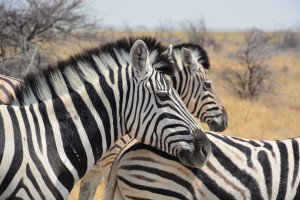Etosha National Park

There is an ancient myth among the peoples of Namibia that tells the story of a great war between tribes. One tribe lost all its men to the battle. When the women mourned their loss, their tears formed “The great white place”, or Etosha in native tongue.
Etosha National Park covers more than 20,000 sq km around a flat, bright white piece of salt desert known as the Etosha pan. The pan was at some point a lake but these days it fills up with water only after especially heavy rains a few days per year. The landscape is barren. One is mystified looking out across the pan as mirages readily form, giving the illusion of plentiful water sources in the distant heat. In fact, Phineas and Eilir believed the whole time that we were heading towards the beach. To add to the sense of displacement, Etosha has a very unique look thanks to the white dust from the pan that covers most of the trees and shrubs, as well as tinges the hides of elephants after a dust bath. Despite the dry, harsh conditions, Etosha is home to 114 mammal species, 340 bird species, 16 reptile and amphibian species, and one type of fish. Although not quite as impressive as the Serengeti, Etosha is a really cool place. It is incredibly family friendly as it is very convenient to watch wildlife from one’s own vehicle, thanks to a large number of waterholes, some natural, some man-made. For most of the year the waterholes are the only places with any water so the animals don’t have much choice if they are thirsty. All you have to do is hang out next to a waterhole and wait for the animals to show up, and they show up in droves, allowing one to watch a theater of animals, each taking their place on the stage.
We stayed one night at Okaukuejo lodge, which is one of the biggest and oldest lodges. What it lacked in charm it more than made up for in abundance of animals at the lodge’s own waterhole. After dinner, we walked down to the waterhole and took a seat at one of the benches to enjoy the show. Within a span of a couple of hours, we saw 5 black rhinoceros, 3 large elephants, tens of giraffes, gemsbok (Namibia’s national animal, aka Oryx), and jackals as the sun was setting behind the waterhole. It was quite an amazing experience. We stayed in the area for another 3 days and did a number of drives across the park, spotting animals and snapping pictures while the kids were checking them off on self-made safari lists.
Comments are closed.















































Wow… An hey, those Black Rhinos sure look white..